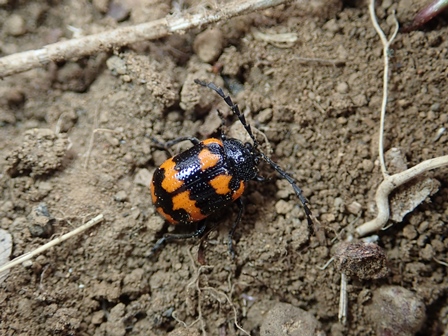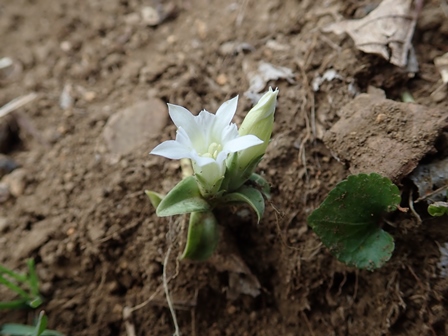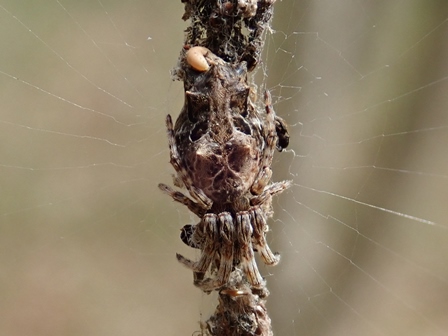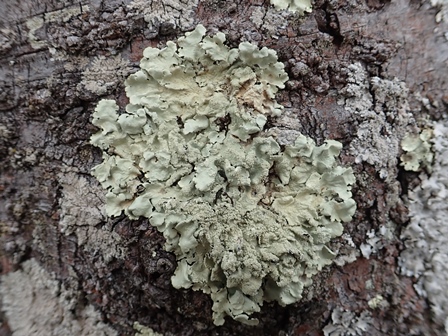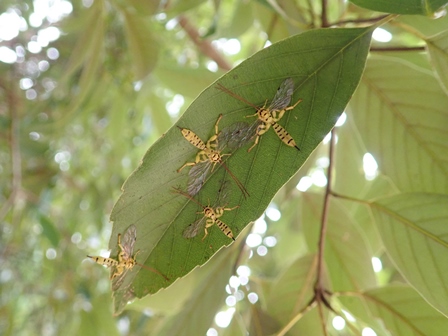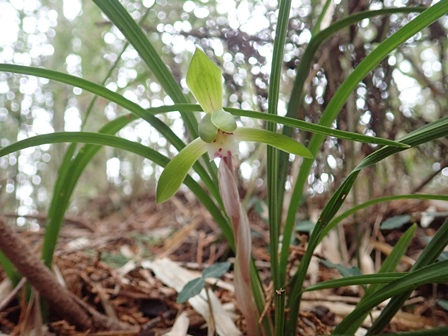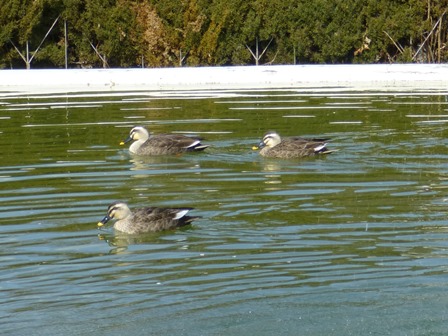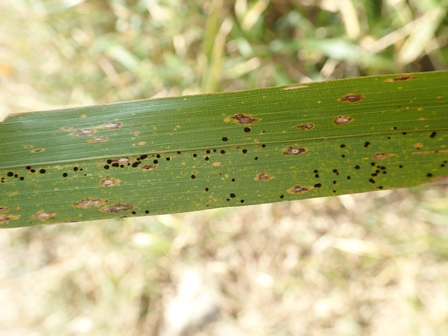フィールド日記
2021年03月
2021.03.30
イタドリハムシ
駐車場のそばでイタドリハムシを見つけました。名前の通り、主にイタドリを食草とするハムシです。黒地にオレンジ色の斑紋がよく目立ち、一見するとテントウムシのようにも見えます。毒をもつテントウムシに擬態し、身を守っていると考えられます。
I found a leaf beetle called "Itadori-hamushi (イタドリハムシ)" near the parking area. "Itadori (イタドリ)" in its name are some kinds of plants and they literally eat the plants. They have bright orange spots on the black-base body so they look like a ladybug. They probably mimic toxic ladybugs to protect themselves from their predators.
2021.03.26
シロバナフデリンドウ
クヌギ林の林床でシロバナフデリンドウが咲いていました。フデリンドウは青紫色ですが、白花品をシロバナフデリンドウと呼び、区別しています。今年もたくさんのフデリンドウが咲いていますが、見つけられた白花品はこの1株のみでした。
A "Shirobana-Fuderindou (シロバナフデリンドウ)" plant is in bloom on the Japanese chestnut oak woodland floor. In general, the flowers of "Fuderindou (フデリンドウ)" plants are violet, but there are white ones and we call them "Shirobana-Fuderindou (シロバナフデリンドウ)". Many "Fuderindou (フデリンドウ)" plants are in bloom this year again, but I was able to find only this "Shirobana-Fuderindou(シロバナフデリンドウ)" plant.
2021.03.23
ゴミグモ
共生の森でゴミグモを見つけました。ゴミグモは巣の中心に食べかすや脱皮殻などのゴミを帯状に付着させる習性があります。
ゴミの中にはゴミグモが潜んでおり、ゴミに擬態することで捕食者から身を守っていると考えられます。しかし、写真をよく見ると、腹部の先端に幼虫が見られます。これはクモに寄生するクモヒメバチの幼虫です。ゴミグモの擬態もクモヒメバチを欺くことはできないようです。
I found a spider called "Gomi-Gumo (ゴミグモ)". "Gomi (ゴミ)" means "trash". They literally have a custom that they gather trash like leftovers and put them on the center of their webs. They hide in the trash to protect themselves from attacks of their predators. However, taking a closer look, you can find a worm on the tip of the abdomen. It is a larva of a wasp that parasitizes spiders. It seems that the mimicry of the spiders can't trick wasps.
2021.03.19
キウメノキゴケ
桜の木の樹皮にキウメノキゴケが見られました。菌類と藻類の共生体である地衣類のなかまです。名前の通り、他のウメノキゴケのなかまに比べると黄色っぽく見えます。
パスチュールと呼ばれるブツブツした構造が地衣体表面にあるのが特徴です。
I found lichens called "Ki-Umenokigoke (キウメノキゴケ)" on the bark of a cherry blossom. Lichens are a symbiont that consists of fungi and algae. "Ki" in its name means "yellow" and they are literally yellowish compared to other lichens in the "Umenokigoke" group. They have a small wart-like feature on the surface, which is called "pustules" in jargon.
2021.03.16
ミノオキイロヒラタヒメバチ
樫の木の葉の上で越冬しているミノオキイロヒラタヒメバチを見つけました。足を水平に開き、ぴったりと葉にくっついていました。この葉にだけ4匹が集まっていたので、集団で越冬する性質があるようです。ヒメバチは他の昆虫に寄生する寄生蜂として知られています。
I found a group of ichneumon wasps which is staying over the winter on a leaf of oak tree. They are called "Minoo-Kiiro-Hirata-Himebachi (ミノオキイロヒラタヒメバチ)". They horizontally stretched their legs and clung to the leaf. As they are seen only on the leaf, they seem to have a habit to stay over the winter as a group. Ichneumon wasps are known as parasitoid wasps that parasitize other insects.
2021.03.12
シュンラン
ヒノキ林でシュンランが咲いていました。和名は春に咲く蘭を意味します。乾燥した落葉樹林内に生えるとされますが、不二聖心ではヒノキ林の林道沿いに見られることが多いです。
"Shun-ran (シュンラン)" plants are in bloom in the Japanese cypress woodland. The Japanese name "春蘭" in Kanji means "orchids that bloom in spring". They are supposed to grow in dry deciduous forests, but in Fuji-Seishin, they are seen along the path through the Japanese cypress woodland.
2021.03.09
カルガモ
築山の池にカルガモが飛来していました。カルガモは身近な池や河川で周年見られる留鳥ですが、不二聖心では時々プールや池に飛来することがあります。過去の記録を見ると春に見られることが多いようです。
I saw wild ducks called "Karugamo (カルガモ)" which came flying to the pond in an artificial hill. They are sedentary birds that are seen all year round at ponds and rivers around us. We can sometimes see them in our school's pool and pond. According to the previous records, they seem to be often seen in spring here.
2021.03.05
ギンゴケ
校舎の壁でギンゴケを見つけました。強い光や乾燥などに強く、全国の道端で最もよく見られるコケの一つです。名前は、乾燥時に太陽光を反射し、銀色に輝いて見えることに由来します。
この群落は、乾燥しているとき(写真左)はほとんど白色ですが、湿っているとき(写真右)は緑が濃くなります。乾燥時は太陽光を反射することで身を守り、湿潤時には光を吸収し光合成をするための工夫と考えられます。
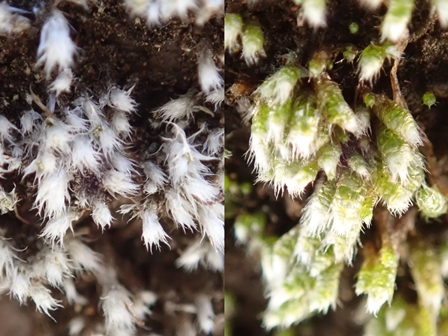
I found a moss called "Gingoke(ギンゴケ)" on the school building's wall. As they are resistant to strong sunlight and dryness, they are one of the most common moss plants seen along the roads in Japan. The name means "silver moss" and comes from their silver color when the dry moss reflects sunlight.
This colony is almost white when they are dehydrated but become greener when they are moist. It's considered that, when they are dehydrated, they reflect the sunlight to protect themselves and when they are moist, they can photosynthesize.
2021.03.02
ササのさび病菌
ササの葉の裏面に褐色のつぶつぶを見つけました。ササ類に寄生するさび病菌の一種(Puccinia kusanoi Dietel)です。さび病菌のなかまは異なる宿主の間を行き来したり、5種類の形態や機能の異なる胞子をつくったりなど、複雑な生活史を持っています。
下の写真は褐色のつぶつぶを顕微鏡で観察したものです。これは冬胞子と呼ばれる越冬に適した耐久性のある胞子で、褐色のつぶつぶは冬胞子の集まりであったことがわかります。
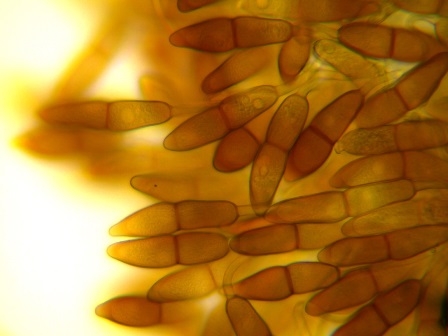
I found these brown particles on the back leaves of the Sasa plants. They are a rust fungus (Puccinia kusanoi Dietel) that is parasitic on Sasa Plants. Rust fungi have a complex life cycle that they move back and forth between different host plants and have five different spores.
The second photo is the brown particles enlarged by a microscope. These are winter spores that enable them to stay over the winter. The brown particles are the masses of the spores.
- 1 / 1


